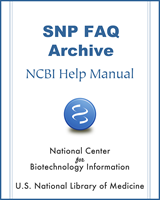NCBI Bookshelf. A service of the National Library of Medicine, National Institutes of Health.
SNP FAQ Archive [Internet]. Bethesda (MD): National Center for Biotechnology Information (US); 2005-.
This publication is provided for historical reference only and the information may be out of date.
Is it possible to get the XML files for build 35? The download directories only have build 36.
Could you tell me the number of validated and unvalidated SNPs in dbSNP build 120?
How do I locate information for two fairly old submitted SNPs: ss35527513 and ss35527511?
I know you have just released B130 for human, but I really need to download Human b126. Where can I find it?
Although you can find mapping tables for B126 on dbSNP’s FTP site, please note that dbSNP doesn't support complete archives of older builds. We strongly suggest that you use the most recent build to date (build 130) since it was created with improved mapping processes and contains corrections for past errors.(06/23/09)
Broad’s Haploview shows HapMap genotype data along with SNP data mapped to assembly 35. Current dbSNP data is mapped to build 127 (assembly 36). How do I use dbSNP to map a list of refSNPs to assembly 35?
dbSNP does not support searches for older assembly coordinates. You can get coordinates from dbSNP build 125 and 126, which were based on genome assembly 35 from the SNPContigLoc tables for those builds. You will find these tables in the organism_data subdirectory, which is located in the human database directory of dbSNP’s FTP site. (9/28/07)
Is it possible to get the XML files for build 35? The download directories only have build 36.
Space limitations prevent us from keeping more than the most current build on our FTP site. The current XML files, however, do contain the mapping information for the previous build (i.e. build 35). (10/20/06)
Could you tell me the number of validated and unvalidated SNPs in dbSNP build 120?
Build120 was released on Mar 16 2004 12:00AM and mapped to the NCBI Human Genome 34 ver. 3. Build 120 has a total of 9,098,790 human SNPs, and 4,267,639 of those are validated.
Please note that dbSNP validation status is delineated by various levels. You can see definitions for the various validation status levels by clicking on the words "Validation Status" located on any RefSNP page in the table header just below the banner that reads “Submitter records for this RefSNP Cluster”. (3/14/05)
Where can I find the history of dbSNP mouse submissions — specifically those from Celera, as well as other commercial and non-commercial labs?
- 1.
Go to the dbSNP home page.
- 2.
Locate the Submission Information section and select the “New Batches” link.
- 3.
Select “mouse_10090” from the organism dropdown menu and then choose Select “Variation submissions (SNP)” from the Batch Type dropdown menu
- 4.
Click the Search Batch button at the bottom of the page, and you will be given a list of SNP batch submissions that includes submitter handle, batch ID, and the number of variations submitted in descending calendar order. (2/21/06)
How do I query dbSNP so that it will return a flat or xml file containing the new RefSNP (rs) ID number into which a previously valid rs recently merged?
You can get the rs merge history of all rs numbers from your organism’s (human in this case) RsMergeArch table located in on the dbSNP ftp site.
The following example shows that rs4344934 has been merged to rs1107123:
gzcat RsMergeArch.bcp.gz | grep 4344934
4344934 1107123 123 1 2004-09-24 18:49:00 2004-10-10
11:55:00 1107123 1Also, you can now retrieve a list of merged rs numbers from Entrez SNP. Just type “mergedrs” (without the quotation marks) in the text box at the top of the page and click the “go” button. Each entry in the returned list will include the old rs numbers that has merged, and the new rs number it has merged into (with a link to the refSNP page for the new rs number). You can limit the output to merged rs numbers within a certain species by clicking on the “Limits” tab and then selecting the organism you wish from the organism selection box. (5/25/05:11/03/08)
Some RefSNP (rs) numbers in dbSNP are merged into one rs number. Where does dbSNP provide the merge history?
You can now retrieve a list of merged rs numbers from Entrez SNP. Just type “mergedrs” (without the quotation marks) in the text box at the top of the page and click the “go” button. Each entry in the returned list will include the old rs numbers that has merged, and the new rs number it has merged into (with a link to the refSNP page for the new rs number). You can limit the output to merged rs numbers within a certain species by clicking on the “Limits” tab and then selecting the organism you wish from the organism selection box.
You can also use the RsMergeArch table located in the dbSNP FTP site. (11/08/05:11/03/08)
How do I locate information for two fairly old submitted SNPs: ss35527513 and ss35527511?
Search for these ss numbers by using the “Search by ID” query module located on the dbSNP homepage:
- 1.
Enter the ss ID number in the input text box.
- 2.
Select "NCBI Assay IDs" from the drop down menu to the right of the input text box.
- 3.
Click “Search”
- 4.
You will get a “Submitted SNP(ss) Report” for the ss ID you entered for your search.
- 5.
Click on the blue ss Id number located at the top of the report to go to the submitted SNP page for this ss ID number, or click on the blue rs Id number also located at the top of the report to get refSNP mapping information. (10/14/05)
- Finding Old Build Data - SNP FAQ ArchiveFinding Old Build Data - SNP FAQ Archive
Your browsing activity is empty.
Activity recording is turned off.
See more...
